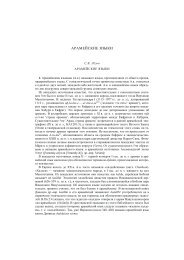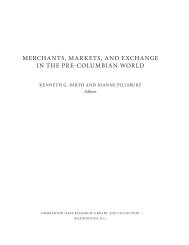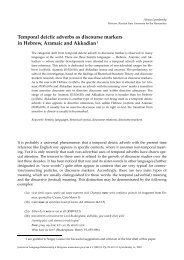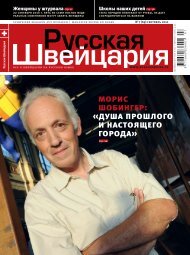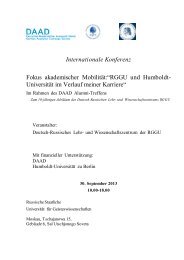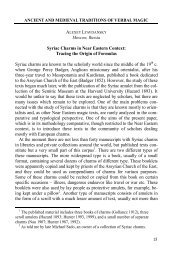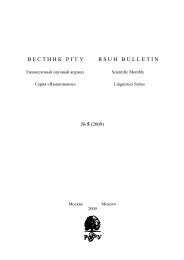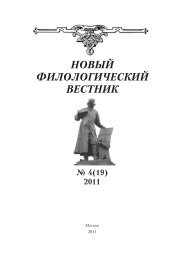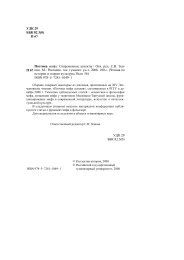Akkadian Sentences about the Present Time (II/2)
Akkadian Sentences about the Present Time (II/2)
Akkadian Sentences about the Present Time (II/2)
You also want an ePaper? Increase the reach of your titles
YUMPU automatically turns print PDFs into web optimized ePapers that Google loves.
766 Morphosyntax and Text Structure in <strong>Akkadian</strong>VA labšu ‘clad, arrayed,’ attested predominantly in SB lexical textswithin a compound labiš kitê ‘linen-wearer’ (a temple official).(40) lapātum ‘to touch; to affect; to write down’The SC is frequent in A readings and common in P readings, whichmight be expected of certain low-transitivity more-than-one-place verbs.Cf. <strong>the</strong> following examples of <strong>the</strong> A usage in OB: awīlû … la-a[p-t]u-ni-inni‘die Männer … haben mich angegriffen’ (AbB 8, 22:3ff.), ana alpim PNu PN 2 la-ap-tu-ni-a-ti ‘PN and PN 2 keep bo<strong>the</strong>ring (?) us on account of <strong>the</strong>ox’ (TIM 2, 78:49 = CAD L 86a, tentatively accepted in AbB 8, 78:49‘greifen uns hart wegen (dieses) Rindes an’), tamû qaqqad ilī-šunu la-ap-tu‘<strong>the</strong>y have sworn, <strong>the</strong>y have touched <strong>the</strong> head of <strong>the</strong>ir god’ (MDP 24,337rev.:12 = CAD L 85a, OB Susa). In OB, <strong>the</strong> P reading is well attestedfor <strong>the</strong> meaning ‘to water,’ ‘to smear a surface with a liquid’: ¢ēm eqel GNmala mê la-ap-tu šupram … u ¢ēm eqel GN 2 mala eršu u mê la-ap-tu šupram‘schreibe mir einen Bericht über das Feld in GN, wieviel bewässert ist …schreibe mir auch einen Bericht über das Feld in GN 2 , wieviel bestelltund wieviel bewässert ist’ (AbB 6, 114:19–25), šumma martum damam la-apta-at‘if <strong>the</strong> gall bladder is smeared with blood’ (YOS 10, 31 xii 11). Cf.also an OB example for <strong>the</strong> meaning ‘to affect,’ with <strong>the</strong> cause participantin <strong>the</strong> accusative: barley kalmatam la-pi-it ‘is infested by vermin’ (AbB 14,56:21). This P usage is well-known in OA: ni-ša-me-ma TÚG.ÚI.A sá-sá-amlá-áp-tù ‘we have heard that <strong>the</strong> textiles are moth infested’ (CTMMA I,77:7ff.); 20 kīma šīmum ša akkidīyē lá-áp-tù-ni ‘since <strong>the</strong> trade in <strong>Akkadian</strong>textiles has been affected (I have not sent you any)’ (TCL 1, 2:11f., tr. ofVeenhof 1972:377). In Kültepe, <strong>the</strong> P reading in <strong>the</strong> meaning ‘to be writtendown, recorded, entered into a document’ is ubiquitous, e. g. ‘x silverina ¢uppim labīrim la-ap-tù are recorded on <strong>the</strong> old tablet’ (TCL 21, 184:6),šu-um-šu i-na É kà-ri-im lá-pí-it ‘sein Name ist im Karum-Hauseingetragen’ (Prag I 482:6f.). In OB, <strong>the</strong> SC is also used in <strong>the</strong> meaningdirectly derived from <strong>the</strong> VA (‘to be bad, evil-portending, abnormal,anomalous’): têrētum mādiš la-ap-ta ‘<strong>the</strong> exta are very anomalous’ (ARM 2,manifestation of <strong>the</strong> detransitive meaning, along with direct reflexive, reciprocal,passive, etc.). The SC labiš survived just because <strong>the</strong> SC is in itself detransitive, soin this case <strong>the</strong>re was no need to renew <strong>the</strong> morphological shape. Kouwenbergforthcoming counts labāšu with “middle verbs” (3.5.2.4, 18.3.1, with references toearlier literature on this kind of verbs in Semitic).20See Michel 1998 for more examples of this kind.




